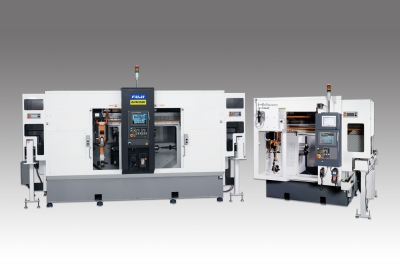
Fuji Machine America Corp. says its ANW-3500 fully automated twin-spindle Lathe is impressive on its own, but when combined with Fuji’s Fully Automated HM-3400 milling machine (optimized to integrate), it opens up a whole new world of machining possibilities and efficiencies. Both machines of this cell have built-in robots.
Suitable for automotive, energy, aerospace, construction and agriculture equipment applications, this turning and milling/drilling cell combination accommodates heavy workloads and large machine envelopes. Applications include large hubs and smaller diff cases, as well as disk brakes and rotors, flanges, hubs, differential cases, valves and seats, and downhole subs.
The operator-friendly ANW-3500’s dual spindles operate at 20/25 hp power each. An A2-6 spindle nose comes standard; an A2-8 spindle nose is available as an option for larger size chucks (12” to 15”). The ANW-3500’s swing arm, dual-hand robot can handle up to 7kg (15.4 lbs) per side. The Z-axis stroke is reportedly substantially longer than conventional gantry loaded dual parallel spindle machines on the market, allowing for longer length parts.
The modular design of Fuji’s HM-3400 milling cell allows for line integration with Fuji’s ANW, as well as ANS, CSD and TN models. The combination of the ANW-3500 and the HM-3400 offers drilling, milling and turning operations integrated into a modular production line running parallel tasking at the same time, and enables a shorter takt time for higher volume of parts per shift.
Featuring four axes (X, Y, Z and C), the HM-3400 is capable of five-face machining in one chucking. Equipped with Fuji’s high-speed swing arm or gantry-type robot, the HM-3400 provides workpiece loading and unloading efficiency. The tools are mounted in a circular arrangement. Axial and radial holders can be freely attached anywhere on the turret of the HM-3400. Attaching an axial holder diagonally creates a B-axis on the machining center for machining angular holes. Turret tool capacity of the HM-3400 is offered with turrets of six, 10 and 15 tool stations.
Contact Details
Related Glossary Terms
- gang cutting ( milling)
gang cutting ( milling)
Machining with several cutters mounted on a single arbor, generally for simultaneous cutting.
- lathe
lathe
Turning machine capable of sawing, milling, grinding, gear-cutting, drilling, reaming, boring, threading, facing, chamfering, grooving, knurling, spinning, parting, necking, taper-cutting, and cam- and eccentric-cutting, as well as step- and straight-turning. Comes in a variety of forms, ranging from manual to semiautomatic to fully automatic, with major types being engine lathes, turning and contouring lathes, turret lathes and numerical-control lathes. The engine lathe consists of a headstock and spindle, tailstock, bed, carriage (complete with apron) and cross slides. Features include gear- (speed) and feed-selector levers, toolpost, compound rest, lead screw and reversing lead screw, threading dial and rapid-traverse lever. Special lathe types include through-the-spindle, camshaft and crankshaft, brake drum and rotor, spinning and gun-barrel machines. Toolroom and bench lathes are used for precision work; the former for tool-and-die work and similar tasks, the latter for small workpieces (instruments, watches), normally without a power feed. Models are typically designated according to their “swing,” or the largest-diameter workpiece that can be rotated; bed length, or the distance between centers; and horsepower generated. See turning machine.
- machining center
machining center
CNC machine tool capable of drilling, reaming, tapping, milling and boring. Normally comes with an automatic toolchanger. See automatic toolchanger.
- milling
milling
Machining operation in which metal or other material is removed by applying power to a rotating cutter. In vertical milling, the cutting tool is mounted vertically on the spindle. In horizontal milling, the cutting tool is mounted horizontally, either directly on the spindle or on an arbor. Horizontal milling is further broken down into conventional milling, where the cutter rotates opposite the direction of feed, or “up” into the workpiece; and climb milling, where the cutter rotates in the direction of feed, or “down” into the workpiece. Milling operations include plane or surface milling, endmilling, facemilling, angle milling, form milling and profiling.
- milling machine ( mill)
milling machine ( mill)
Runs endmills and arbor-mounted milling cutters. Features include a head with a spindle that drives the cutters; a column, knee and table that provide motion in the three Cartesian axes; and a base that supports the components and houses the cutting-fluid pump and reservoir. The work is mounted on the table and fed into the rotating cutter or endmill to accomplish the milling steps; vertical milling machines also feed endmills into the work by means of a spindle-mounted quill. Models range from small manual machines to big bed-type and duplex mills. All take one of three basic forms: vertical, horizontal or convertible horizontal/vertical. Vertical machines may be knee-type (the table is mounted on a knee that can be elevated) or bed-type (the table is securely supported and only moves horizontally). In general, horizontal machines are bigger and more powerful, while vertical machines are lighter but more versatile and easier to set up and operate.
- modular design ( modular construction)
modular design ( modular construction)
Manufacturing of a product in subassemblies that permits fast and simple replacement of defective assemblies and tailoring of the product for different purposes. See interchangeable parts.
- parallel
parallel
Strip or block of precision-ground stock used to elevate a workpiece, while keeping it parallel to the worktable, to prevent cutter/table contact.
- turning
turning
Workpiece is held in a chuck, mounted on a face plate or secured between centers and rotated while a cutting tool, normally a single-point tool, is fed into it along its periphery or across its end or face. Takes the form of straight turning (cutting along the periphery of the workpiece); taper turning (creating a taper); step turning (turning different-size diameters on the same work); chamfering (beveling an edge or shoulder); facing (cutting on an end); turning threads (usually external but can be internal); roughing (high-volume metal removal); and finishing (final light cuts). Performed on lathes, turning centers, chucking machines, automatic screw machines and similar machines.






